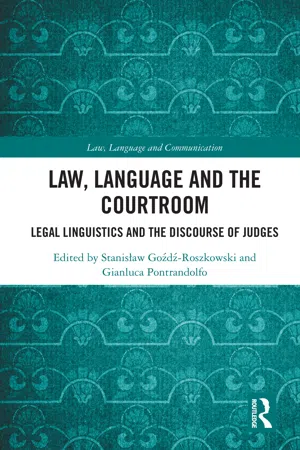
Law, Language and the Courtroom
Legal Linguistics and the Discourse of Judges
- 246 pages
- English
- ePUB (mobile friendly)
- Available on iOS & Android
Law, Language and the Courtroom
Legal Linguistics and the Discourse of Judges
About this book
This book explores the language of judges. It is concerned with understanding how language works in judicial contexts. Using a range of disciplinary and methodological perspectives, it looks in detail at the ways in which judicial discourse is argued, constructed, interpreted and perceived. Focusing on four central themes - constructing judicial discourse and judicial identities, judicial argumentation and evaluative language, judicial interpretation, and clarity in judicial discourse - the book's ultimate goal is to provide a comprehensive and in-depth analysis of current critical issues of the role of language in judicial settings. Contributors include legal linguists, lawyers, legal scholars, legal practitioners, legal translators and anthropologists, who explore patterns of linguistic organisation and use in judicial institutions and analyse language as an instrument for understanding both the judicial decision-making process and its outcome.
The book will be an invaluable resource for scholars in legal linguistics and those specialising in judicial argumentation and reasoning ,and forensic linguists interested in the use of language in judicial settings.
Frequently asked questions
- Essential is ideal for learners and professionals who enjoy exploring a wide range of subjects. Access the Essential Library with 800,000+ trusted titles and best-sellers across business, personal growth, and the humanities. Includes unlimited reading time and Standard Read Aloud voice.
- Complete: Perfect for advanced learners and researchers needing full, unrestricted access. Unlock 1.4M+ books across hundreds of subjects, including academic and specialized titles. The Complete Plan also includes advanced features like Premium Read Aloud and Research Assistant.
Please note we cannot support devices running on iOS 13 and Android 7 or earlier. Learn more about using the app.
Information
Part I
Constructing judicial discourse and judicial identities
1 The judicial English Eurolect
A genre profiling of CJEU judgments
1 The Court of Justice of the European Union and its judicial style
In direct actions, the Court adjudicates on the dispute between the parties, whereas in preliminary rulings it simply gives advice on a specific point of EU law, leaving the final resolution of the dispute to the national court.(Albors-Llorens 2017, p. 265)
Table of contents
- Cover
- Half Title Page
- Series Page
- Title Page
- Copyright Page
- Contents
- List of contributors
- Foreword
- Editors’ introduction
- Part I Constructing judicial discourse and judicial identities
- Part II Judicial argumentation and evaluative language
- Part III Judicial interpretation
- Part IV Clarity in judicial discourse
- Index